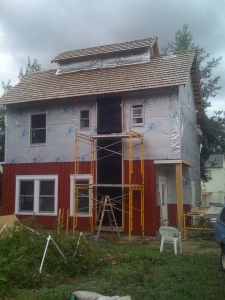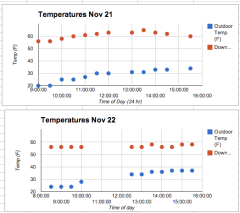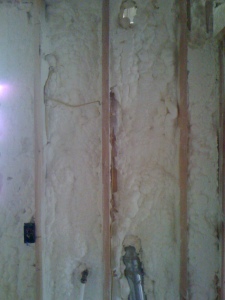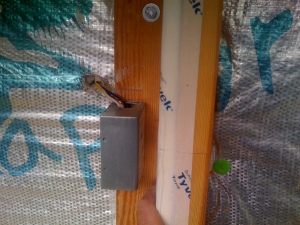The artifact below will be dated when you read this, but look at the weaving of art, craft, food, science (emphasis mine).
What follows is a schedule of hands-on workshops on how to make wood-fired ovens out of earth, good sourdough bread, and natural plasters to sculpturally enhance any building; also a list of slide presentations on earthen and natural building. These are offered by Kiko Denzer, and others, as noted. Feel free to share/forward the info; or let me know if you’d like to be removed from this list. (We also have a possible APPRENTICESHIP opportunity for the right person(s). More about this at the end of the email.)
Below are dates, locations, and information specific to each workshop. Registration info and a general description of the workshops are at the end.
WORKSHOPS:
April 12-13
Ovens & Bread
Philomath, Oregon, Gathering Together Farms
Gathering Together Farm is a local, community-sponsored farm. We’ll be building an oven for their public restaurant and event operation. Limited number of openings available. $175, includes lunch.
MAY 26-27 OR May 31-June 1
Ovens & Bread
NE Portland, Oregon
A residential oven in a neighborhood setting. Probably bi-lingual, English/Spanish! Limited openings. $175, includes lunch.
(This is also a good time to make mud in Portland, during the annual Village Building Convergence, featuring speakers, events, and natural building projects around the city. See cityrepair.org for more.)
June 9-13
Earth & art for your home: design, sculpture, & decoration with natural materials
Coquille, Oregon, at the North American School of Natural Building, with Linda Smiley and others
Natural plasters, paints, and finishes to design, sculpt, and help finish an existing cob cottage. We’ll start with a review of the principles of design, site analysis, 3-dimensional space and spatial dynamics, and practical beauty. Then we’ll get muddy; work will be interspersed with discussion and demos covering technical, design, and materials issues, including a full range of earthen and lime plasters, clay paints, and sculptural mixes. Explore and experiment to gain practical experience to apply to your own design problems. The site features a broad array of earthen and natural buildings and related techniques. Contact the school at 541-396-1825, or see fee and registration details online at http://www.cobcottage.com
July 10-20, or 26-27
Ovens & Bread
Pringle Creek Community, Salem, Oregon
Registration is limited
August 23-24
Ovens & Bread
near Burnt Woods, Oregon, at the site of the future Oregon Folk School
PRESENTATIONS
Sunday, March 16
Building community out of the mud, at the Community Built Association CONFERENCE,
Asilomar center, Monterrey, CA
A conference of public artists, park designers, and community builders. Founded in 1989, the Community Built Association is a not-for-profit association of professionals who work with local communities and volunteers to design, organize, create, and reshape their own physical environments through the creation of parks, playgrounds, murals, or sculpture. http://www.communitybuilt.org. Or contact Leon Smith: leon@earthplay.net
May 30th, noon
Mud 101: Earthen building and other arts
A slide presentation at Portland’s Green Home Show
Portland Expo Center, Portland (http://www.betterlivingshow.org)
June 1-8
Oven demos & presentations
Ashland, Oregon:
Demos and presentations will accompany a special workshop for students and members of the Willow Wind alternative school community. For more info, contact handprint@cmug.com or call 541-438-4300, after April 31.
How Workshops work:
If you can make mud pies, you can build with earth. Good material is often underfoot. Practical, beautiful, dirt cheap, and faster than you think, mud is also sculptural, colorful, and rich, whether you make ovens, benches, garden walls, or houses. And you can do it with your kids! “Mud ovens” were the original masonry ovens (brick is, after all, fired clay). The ovens we make bake beautiful bread (and anything else), and perform as well as the fancy $4,000 Italian ones. You can build a simple one in a day, learn about cob and natural building – and make the best pizza and breads.
Instructors: KIKO DENZER & HANNAH FIELD
Workshops cover everything you need to know to make an oven and bake anything in it, as well as Hannah’s simple approach to naturally leavened, “artisan” breads. Kiko & Hannah have taught at Bob’s Red Mill, Andrew Whitley’s Village Bakery (UK), the King Arthur Flour Company, and at the Bread Baker’s Guild of America’s “Camp Bread” in San Francisco. Kiko is an artist/ builder and author of Build Your Own Earth Oven (bread chapter by Hannah), & Dig Your Hands in the Dirt: A Manual for Making Art out of Earth (Hand Print Press). Hannah baked professionally for organic bakeries in the UK, and is also an organic gardener and massage therapist. We don’t have a conventional oven — every other week, we bake 25 pounds of whole-grain sourdough in a mud oven. It’s a staple food. Our philosophy for workshops is that we all participate, we all learn, and we all teach. Groups are generally interesting, diverse, and fun. We also believe that the cooking (and growing) of food is essential to true culture. Our hope is that , by working, cooking, learning, and eating together, we maintain the living fabric of a peaceful community and culture.
FORMAT: Both days combine oven-making with bread-baking, adjusted to suit participants. By the second day, we’ll have a “temporary oven” to bake in, and a more permanent oven to finish. We start working at 9 am, and are done by 5 pm.
ACCOMODATIONS are not provided, tho some hosts may have space and and facilities for camping.
FEES: $175 per person for two days of hands-on learning, lunches, and snacks. For those with limited, low, or fixed incomes, we can and do reduce fees; please inquire.
TO REGISTER for the “earth and art in your home” course in Coquille, call 541-396-1825, or goto cobcottage.com.
TO REGISTER for all other courses: Send a check or postal money order for 50% of the course fee, payable to Kiko Denzer, at POB 576, Blodgett OR 97326. Note your first and second choices for workshop dates. Registration fees are non-refundable unless we can fill your space immediately. 20% discount for full pre-payment by 3 weeks before your chosen workshop. When we get your payment, we’ll send confirmation and other info.
MORE INFO/QUESTIONS: Please call 541-438-4300, or email handprint@cmug.com.
BOOKS: The new oven book features a super-insulated design, Hannah’s bread chapter, a chapter on mobile, community, & “rocket” ovens; plus lots of new photos & drawings and completely revised & updated text. Price is $17.95, shipping is free (check or money order to Hand Print Press, POB 576, Blodgett OR 97326. Look inside it (and other titles) at handprintpress.com.
OTHER COURSES (Please note: separate instruction/contact/registration info):
SEE cobworkshops.com, naturalbuildingnetwork.org, &/or do a websearch for your local area (“natural building,” “earth” or “cob” or “clay ovens” etc.). In CA, look up Emerald Earth, the Permaculture Institute of N’n CA (PINC), and many others.
APPRENTICESHIP OPPORTUNITY: This is a home-and-community based invitation to share in and learn from the life of a family that is trying to live, learn, grow, and eat as close as possible to their (rural) home, inspired by a vision of “every man (& woman) ‘neath their vine and fig tree, living in peace and unafraid” — and in community with their (urban and) rural neighbors. Projects include gardening, infrastructure (greywater, etc.), plastering, repair/maintenance of cob buildings, rural community events (including a local folk school start-up), ovens, art & sculpture projects, bread & other food prep, watching out for noisy boys (2 & 5 yrs), playing in the creek, a small publishing business, etc. Asking 4 days/wk of help, cash contribution for room and board, plus (reduced) workshop fees. If you’re interested, write and tell us about yourself and your interests.







